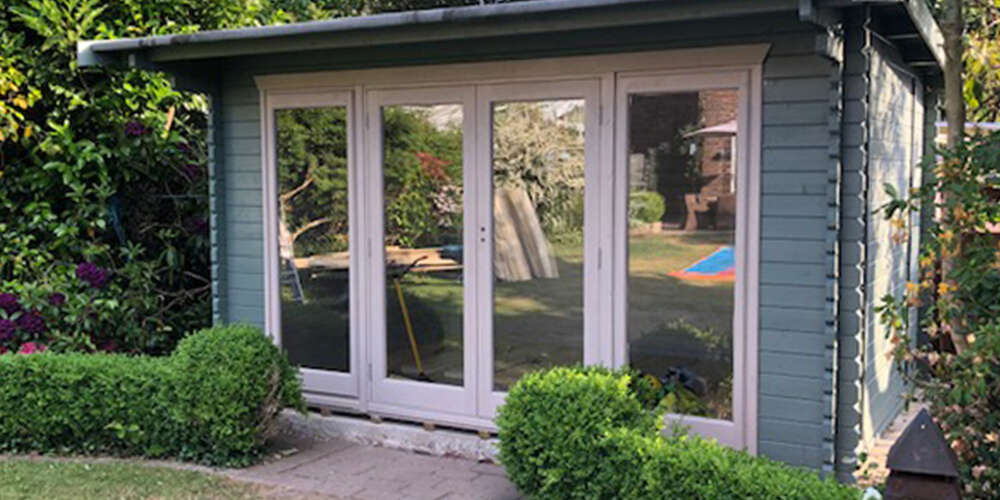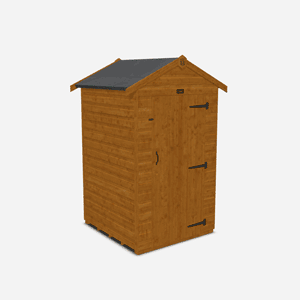How to Paint and maintain your Log Cabin
Published: 05/08/2020

Can You Paint a Log Cabin Exterior?
Absolutely — painting the exterior of your log cabin is not only okay, it’s often a great idea. A coat of high-quality paint can do more than just transform its appearance; it can also help waterproof and protect the timber from rain, UV rays and general wear over time. Beyond the practical benefits, painting your cabin is a simple and enjoyable way to express your personality and make the space your own. Whether you want a natural look that blends into your garden or a bold colour that stands out, today’s paints and tools make it easier than ever to achieve a finish that suits your style. But while it might seem straightforward, painting a log cabin exterior properly does require some preparation and the right choice of products. In this comprehensive guide, we’ll walk you through everything you need to know — from picking the perfect paint to applying it for long-lasting protection and impact.

What is the Best Paint for a Log Cabin?
Giving your log cabin a fresh coat of paint, whether you're refreshing the original colour or opting for a bold new shade, is a great way to add vibrancy to your garden. But more importantly, choosing the right type of paint is essential for protecting your cabin from the elements. A high-quality exterior wood paint doesn’t just improve appearance, it helps defend the timber against moisture, mould, and UV damage, preserving both its structure and longevity. When it comes to log cabins, a quality water-based, joinery grade wood paint for exterior wood or wood preserver is widely regarded as one of the best options.

Alternatively, a water-based wood preserver treatment will penetrate deep into the wood giving years of protection against the weather. It will enhance timber grain with a rich long-lasting protection.
If you're looking for long-lasting performance and great colour choices, we recommend choosing specialist exterior wood paints with low odour and low VOC (volatile organic compound) formulations. These are better for the environment, safer to use, and still deliver excellent coverage and durability.
Explore our full range of wood paint and treatment options, carefully selected to give your log cabin the protection and finish it deserves.
Tools and Materials You Will Need
Before you start painting your log cabin, it’s important to gather all the right tools and materials to ensure the job is done safely, efficiently, and to a high standard. Having the proper equipment will help you achieve a smooth, even finish that not only looks great but offers lasting protection.
Here’s what you’ll need:
- Paint – Choose a high-quality, exterior-grade wood paint suitable for log cabins. We recommend our wood paint and treatment range for excellent colour choice and long-lasting protection.
- Wood Preserver – Apply a preserver before painting to guard against rot, fungi, and insect damage.
- Brushes – Use a stiff bristle brush for prepping the surface and an angled paint brush for detailed areas or tight corners.
- Paint Roller & Extension Pole – Ideal for covering large, flat sections of your cabin more quickly and evenly.
- Masking Tape – Helps protect windows, trims, and fittings from unwanted paint splashes.
- Wood-Friendly Detergent – Essential for cleaning the surface before painting. This removes dirt, algae, and any build-up that could prevent paint from adhering properly.
- Drop Cloth or Dust Sheet – Protects the surrounding area from paint drips and spills.
- Sandpaper (180 Grit) & Electric Sander – For smoothing rough areas and removing old paint or stains. A sander will save time on larger jobs.
- Oil-Based Primer – Use on bare wood to help paint adhere better and provide an extra layer of weather resistance.
- Varnish or Sealant – Optional but recommended for added durability and a long-lasting finish.
- Workwear – Wear protective clothing and a dust mask to keep yourself safe from paint fumes and sanding dust.
With the right materials to hand, you’ll be ready to prep and paint your log cabin properly — giving it the best finish and protection for years to come.
How to Paint Your Log Cabin
When the day comes to paint your log cabin, tackling the job step by step will give you the best results, both visually and in terms of protection. From prepping the surface to sealing in your final coat, here’s how to do it properly:
Step 1: Wash and Prepare the Cabin
Before any paint touches the timber, preparation is key. Begin by sanding down any rough or flaking areas using 180 grit sandpaper or an electric sander. Repair any visible damage or cracks in the wood, and clear away old, peeling paint. Once the surface is smooth, wash the entire cabin using a wood-friendly detergent and water to remove dirt, algae, and grime. Allow it to dry fully before moving on.
Step 2: Apply Preserver to Your Cabin
Next, apply a quality wood preserver to help guard against damp, mould, mildew, and insect damage. Though this step is technically optional, it offers long-term protection and is especially important if your cabin is in a shady or damp area. At Tiger Sheds, we stock a trusted range of wood preservers available in four colours — making it easy to match or complement your chosen paint.
Watch the video on applying Tiger Wood Preserver.
Step 3: Apply Oil-Based Primer
Once the preserver has fully dried, it’s time to apply an oil-based primer. This helps seal the timber, improve paint adhesion, and enhance weather resistance. It’s particularly effective at filling small imperfections and stopping moisture from getting in — extending the life of your topcoat. Be sure to cover all surfaces evenly and allow the primer to dry completely.
Step 4: Paint Your Cabin
Now for the exciting part — painting a log cabin. So, what is the best paint for a log cabin? A high-quality exterior wood paint, like the options in our paint range, which provide great coverage and long-lasting protection. Apply the paint in thin, even layers using a combination of brushes (for edges and detail) and a roller (for larger surfaces). Aim for at least two coats, allowing drying time between each. Paint during mild, dry weather, ideally in the late morning or early afternoon to avoid dew or extreme temperature changes affecting the finish.
For areas exposed to harsher elements, consider adding a clear protective topcoat to further weatherproof the surface.
Optional Step 5: Apply Varnish, Paint or Sealant to Your Cabin’s Floorboards
If your cabin has a timber floor and gets regular foot traffic, finish the job by applying a breathable polyurethane sealant or wood varnish to the floorboards. This adds a layer of protection against scuffs and stains, helping the interior stay smart for longer.

Once the last coat has dried, step back and admire your handiwork. A freshly painted log cabin can transform your garden, giving it a vibrant and personalised touch. And remember — a great paint job shines best on a solid, well-built structure. Browse our full range of Tiger Sheds log cabins to find the perfect fit for your outdoor space.

Conclusion
Painting your log cabin is more than just a cosmetic upgrade, it’s a practical way to protect your investment and express your personal style. By following the right steps, from cleaning and prepping the wood to choosing the right paint and applying finishing touches, you can ensure your cabin stands up to the elements while looking fantastic for years to come.
To recap, you’ll need to:
- Wash and prepare the timber thoroughly
- Apply a quality wood preserver
- Prime the surface with an oil-based primer
- Use durable high-quality wood paint for lasting colour and weather protection
- Optionally, seal interior floorboards for added durability
Whether you're giving your log cabin a seasonal refresh or painting it for the first time, the right tools and products make all the difference. Explore our full range of wood paints, preservers, and log cabins to help you get the best finish possible.
Looking for more help and inspiration? Our garden building guides are packed with expert tips and advice to support you every step of the way.
Ready to get started? Your perfect painted log cabin awaits.








